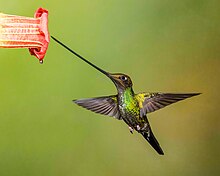| Sword-billed hummingbird | |
|---|---|

| |
| Male | |

| |
| Female sword-billed hummingbird (right) with a buff-tailed coronet
| |
| Scientific classification | |
| Domain: | Eukaryota |
| Kingdom: | Animalia |
| Phylum: | Chordata |
| Class: | Aves |
| Clade: | Strisores |
| Order: | Apodiformes |
| Family: | Trochilidae |
| Tribe: | Heliantheini |
| Genus: | Ensifera Lesson, 1843 |
| Species: | E. ensifera
|
| Binomial name | |
| Ensifera ensifera (Boissonneau, 1840)
| |

| |
| Distribution range of the sword-billed hummingbird | |
| Synonyms | |
|
Ornismya ensifera Boissonneau, 1840 | |
The sword-billed hummingbird (Ensifera ensifera), also known as the swordbill, is a neotropical species of hummingbird from the Andean regions of South America. It is the only member in the genus Ensifera. Among the largest species of hummingbird, it is characterized by its unusually long bill, being the only bird to have a beak longer than the rest of its body, excluding the tail. It uses its bill to drink nectar from flowers with long corollas and has coevolved with the species Passiflora mixta. While most hummingbirds preen using their bills, the sword-billed hummingbird uses its feet to scratch and preen due to its bill being so long.
The sword-billed hummingbird is a trap-line feeder and feeds on nectar, especially from Passiflora mixta and other passionflowers. It also hawks for insects. It breeds from February to March and builds cup nests using moss. The sword-billed hummingbird is listed as being of least concern by the International Union for Conservation of Nature (IUCN) on the IUCN Red List, but is threatened by climate change and deforestation.
- ^ BirdLife International (2016). "Ensifera ensifera". IUCN Red List of Threatened Species. 2016: e.T22687854A93171973. doi:10.2305/IUCN.UK.2016-3.RLTS.T22687854A93171973.en. Retrieved 12 November 2021.
- ^ "Appendices | CITES". cites.org. Retrieved 2022-01-14.
